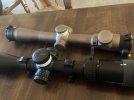I use both. Primarily MOA for LRH, MILS for PRS/Tactical sports. For hunting, I find MOA more natural, with better reticle resolution for the finer wind adjustments encountered for LRH, as well as speed in mentally calculating wind dopes. Interestingly, my first LRH scopes a couple of decades ago were the Leupold MK4's with MOA turrets and Mildot reticles. For this reason I learned the MIL system early on. but my natural thought process is in inches/yards. For hunting, using MOA for multiple applications encountered is a thoughtless process. For competition, most communications, stage structure, and target configurations are designed with MILS in mind so one can generally be more competitive with a MIL scope. With practice it's very fast and effective for the multiple targets and time limits encountered in matches, particularly with reticle use only stages which are frequent. The scaling of the MIL system seems better suited for this type of work(IMO).

